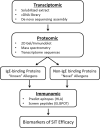Allergy-associated T cell epitope repertoires are surprisingly diverse and include non-IgE reactive antigens
- PMID: 25352946
- PMCID: PMC4210551
- DOI: 10.1186/1939-4551-7-26
Allergy-associated T cell epitope repertoires are surprisingly diverse and include non-IgE reactive antigens
Abstract
We recently identified T cell epitopes associated with human allergic responses. In a majority of cases, responses focused on a few immunodominant epitopes which can be predicted on the basis of MHC binding characteristics. Several observations from our studies challenged the assumption that T cell epitopes are derived from the same allergen proteins that bind IgE. Transcriptomic and proteomics analysis identified pollen proteins, not bound by IgE. These novel Timothy Grass proteins elicited vigorous Th2 responses, suggesting that unlinked T cell help is operational in pollen-specific responses. Thus, the repertoire of antigens recognized by T cells is much broader than IgE-binding allergens. Additionally, we evaluated the use of epitopes from these novel antigens to assess immunological changes associated with Specific Immunotherapy (SIT). We found that a marked decrease in IL5 production is associated with clinically efficacious SIT, suggesting that these novel antigens are potential immunomarkers for SIT efficacy.
Keywords: Cytokine; Epitopes; Specific immunotherapy; T cells; Timothy grass.
Figures
References
Publication types
Grants and funding
LinkOut - more resources
Full Text Sources
Other Literature Sources
Research Materials


